warning light AUDI A4 2016 Manual PDF
[x] Cancel search | Manufacturer: AUDI, Model Year: 2016, Model line: A4, Model: AUDI A4 2016Pages: 278, PDF Size: 70.26 MB
Page 166 of 278
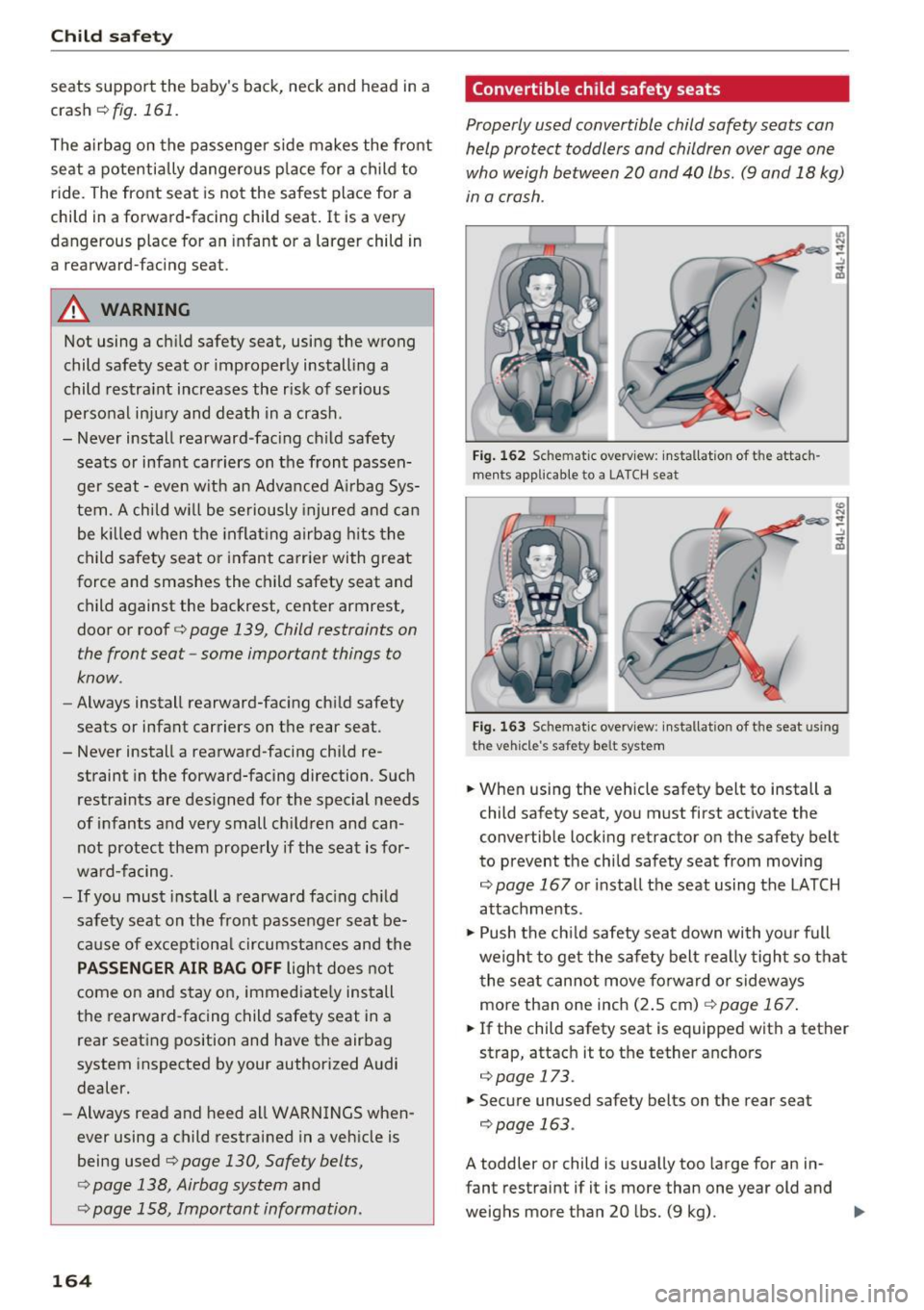
Child safety
seats support the baby's back, neck and head in a
crash
c:>fig. 161.
The airbag on the passenger side makes the front
seat a potentially dangerous p lace for a child to
ride. The front seat is not the safest place for a
child in a forward -facing child seat. It is a very
dangerous place for an infant or a larger child in
a rearward-facing seat.
_&. WARNING
Not using a chi ld safety seat, using the wrong
child safety seat or improperly install ing a
child restra int increases the r isk of serious
personal injury and death in a crash.
- Never install rearward-fac ing ch ild safety
seats or infant carriers on the front passen
ger seat - even w ith an Advanced A irbag Sys
tem. A child w ill be seriously injured and can
be k il led when the inflat ing airbag hits the
child safety seat or infant carrier with great
force and smashes the child safety seat and
child against the backrest, center armrest,
door or roof
c:> page 139, Child restraints on
the front seat -some important things to
know.
-Always install rearward-fac ing ch ild safety
seats or infant carriers on t he rear seat.
- Never install a rearward-facing child re
straint in the forward-facing direction. Such
restra ints are des igned for the special needs
of infants and very small ch ildren and can
not protect them properly if the seat is for
ward-facing.
- If you must install a rearward fac ing ch ild
safety seat on the front passenger seat be
c a use of exceptiona l circumsta nces and the
PASSENGER AIR BAG OFF light does not
come on and stay on, immediate ly install
t h e rearward-facing child safety seat in a
rear seating position and have the airbag
system inspected by your authorized Audi
dealer.
-Always read and heed all WARNINGS when
ever using a child restrained in a vehicle is
being used
c:> page 130, Safety belts,
c:> page 138, Airbag system and
c:> page 158, Important information.
164
Convertible child safety seats
Properly used convertible child safety seats can
help protect toddlers and children over age one
who weigh between 20 and 40 lbs. (9 and 18 kg)
in a crash.
Fig . 162 Schemat ic overv iew : installat ion of the attach
ments applicable to a LA TCH seat
Fig. 163 Schemat ic overv iew: i nstallat ion of the seat using
the vehicle's safety belt system
.. When using the vehicle safety belt to install a
child safety seat, you must first activate the
convertib le locking retractor on the safety belt
to prevent the child safety seat from moving
c:> page 167 or install the seat using the LATCH
attachments .
.. Push the chi ld safety seat down wi th your full
we igh t to get the safe ty belt really tight so that
the seat cannot
move forward or sideways
more than one inch (2 .5 cm)
<=>page 167.
.. If the child safety seat is equipped with a tether
strap, attach it to the tether ancho rs
c:>page 173.
.. Secure unused safety belts on the rear seat
c:> page 163 .
A toddler or child is usually too large for an in
fant restraint if it is more than one year old and
weighs more than 20 lbs. (9 kg).
ll>-
Page 167 of 278
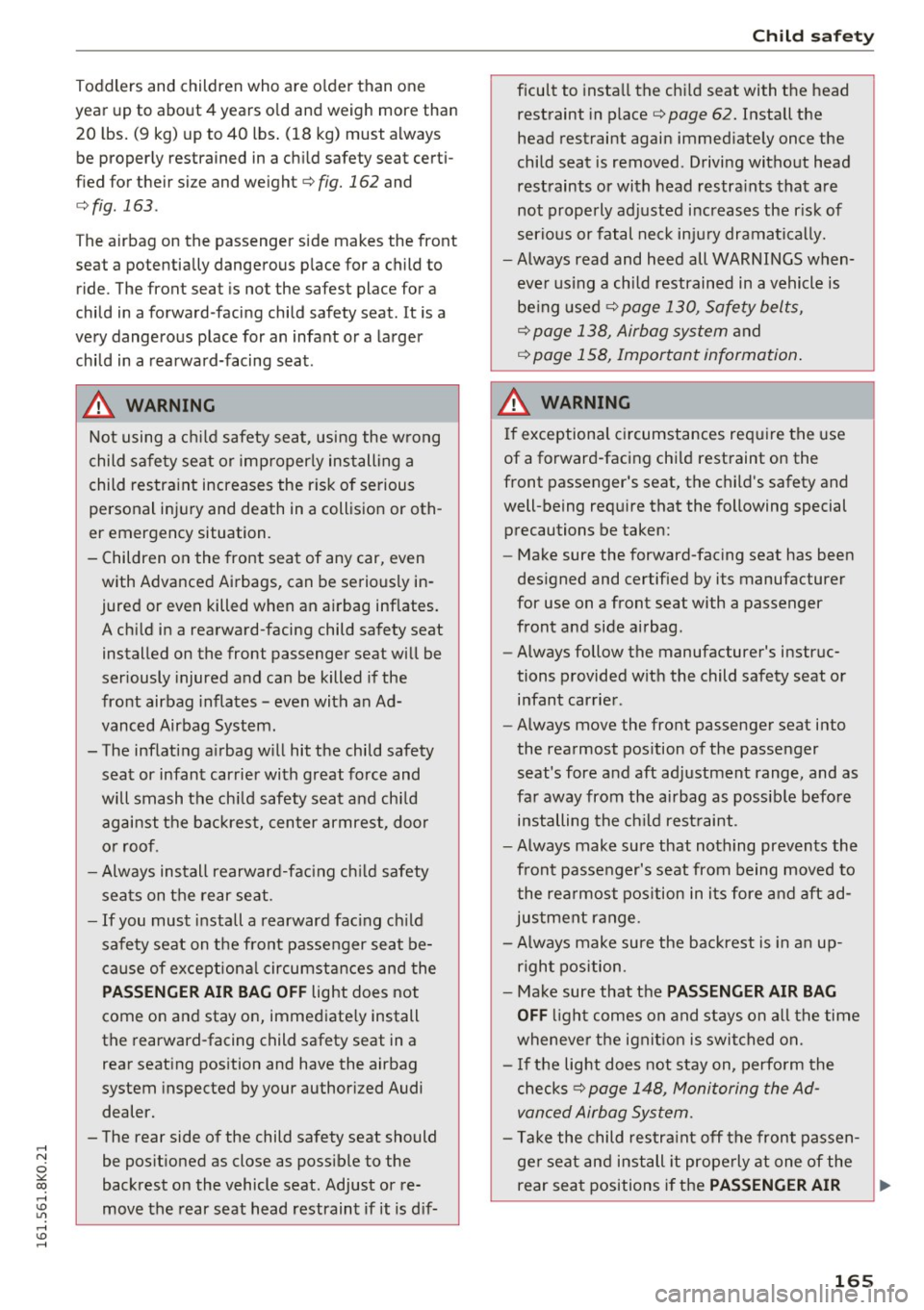
..... N
0 ::..:: co .....
year up to about 4 years old and weigh more than
20 lbs. (9 kg) up to 40 lbs. (18 kg) must always
be properly restrained in a child safety seat certi
fied for their size and weight¢
fig. 162 and
¢ fig. 163.
The airbag on the passenger side makes the front
seat a potentially dangerous p lace for a child to
ride. The front seat is not the safest place for a
child in a forward-facing child safety seat .
It is a
very dangerous place for an infa nt or a larger
child in a rearward-facing seat.
A WARNING
Not using a ch ild safety seat, using the w rong
child safety seat or improperly installing a
child restraint increases the risk of serious
personal injury and death in a collision or oth
er emergency situation.
- Children on the front seat of any car, even with Advanced Airbags, can be seriously in
jured or even killed when an airbag inf lates.
A ch ild in a rearward-facing child safety seat
installed on the front passenger seat will be
seriously injured and can be killed if the
front airbag inflates -even with an Ad
vanced Airbag System.
- The inflating a irbag w ill hit the child safety
seat or infant carrier with great force and
will smash the ch ild safety seat and chi ld
against the bac krest, center armrest, doo r
or roof.
- Always install rearward-fac ing ch ild safety
seats on the rear seat.
- If you must install a rearward fac ing ch ild
safety seat on the front passenger seat be
c ause of exceptiona l circumstances and the
PASSENGER AIR BAG OFF light does not
come on and stay on, immediate ly install
the rearward-facing child safety seat in a
rear seating pos ition and have the airbag
system inspected by your authorized Audi
dealer.
- The rear side of the child safety seat should
be pos it ioned as close as poss ible to the
backrest on the vehicle seat. Adjust or re
move the rear seat head restraint if it is d if-
Ch ild safety
ficult to insta ll the chi ld seat with the head
restraint in place¢
page 62. Install the
head restraint again immediate ly once the
child seat is removed. Driving without head
restraints or with head restra ints that are
not properly adjusted increases the r is k of
serio us or fatal neck inju ry dramatically.
- Always read and heed all WARNINGS when
eve r using a child restrained in a vehicle is
be ing used
r::!;> page 130, Safety belts,
r::!;> page 138, Airbag system and
r::!;> page 158, Important information .
A WARNING
= -
If exceptional circumstances requ ire the use
of a forward-facing chi ld restraint on the
front passenger's seat, the child's safety and
well-being requ ire that the following special
precautions be taken:
- Make sure the forward-fac ing seat has been
des igned and certified by its manufacturer
for use on a front seat with a passenger
front and side airbag.
-Always follow the manufacturer's instruc
tions provided with the child safety seat or
infant carrie r.
- Always move the front passenger seat into
the rearmost pos ition of the passenger
seat's fore and aft adjustment range , and as
fa r away from the airbag as possib le befo re
installing the ch ild rest raint.
- Always make sure that nothing prevents the
front passenger's seat from being moved to
the rea rmost pos ition in its fore and aft ad
justment range.
- Always make sure the backrest is in an up
right position.
- Make sure that t he
PASSENGER AIR BAG
OFF
li ght comes on and stays on all the time
wheneve r the ignit ion is swit ched on.
- If the light does not stay on, perfo rm the
checks
r::!;> page 148, Monitoring the Ad
vanced Airbag System.
- Take the child restra int off the front passen
ge r seat and install it prope rly at one of the
rear seat positions if the
PASSENGER AIR ...,
165
Page 169 of 278
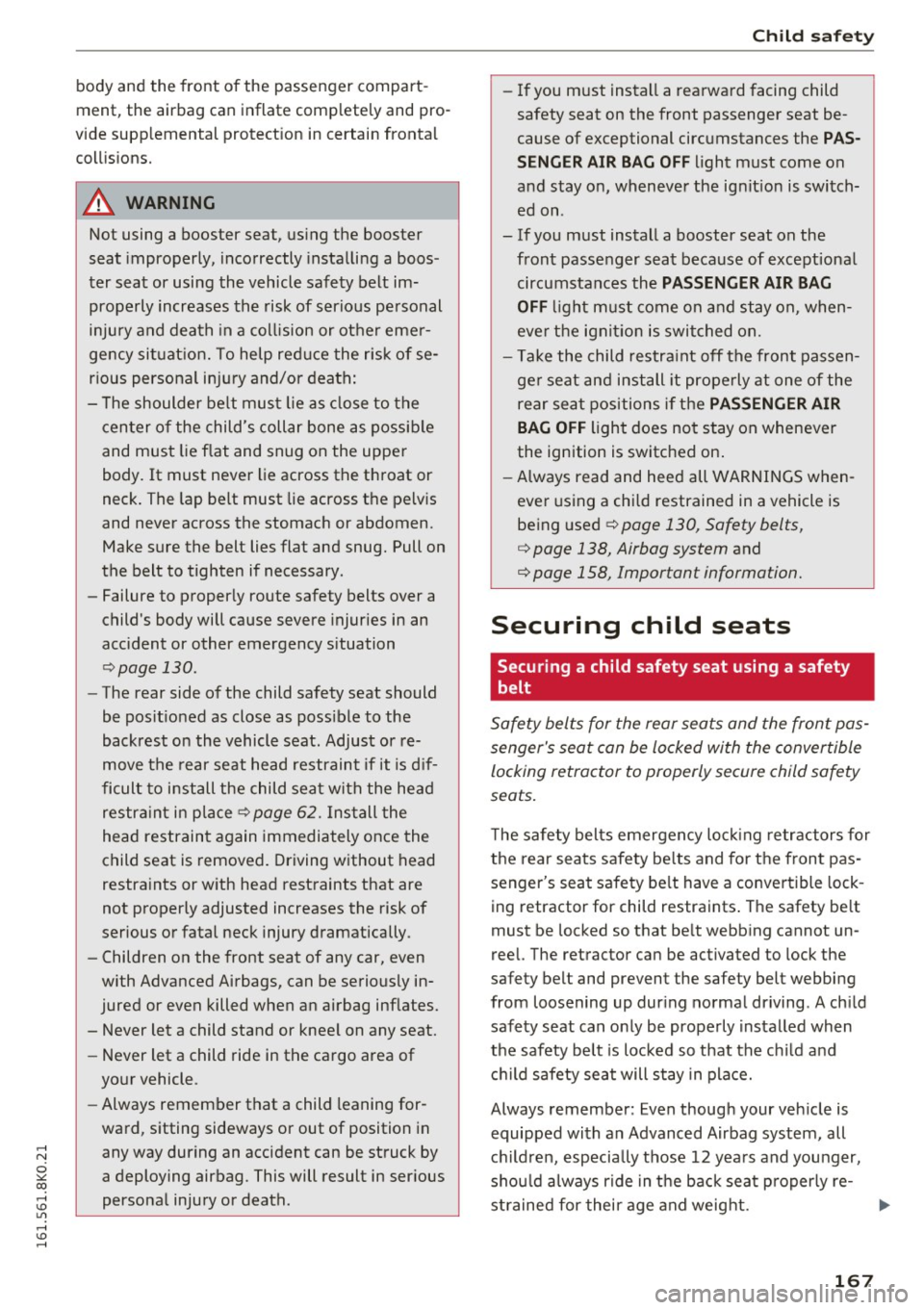
..... N
0 ::..:: co .....
ment, the airbag can inflate completely and pro
vide supp lemental protect ion in certain frontal
collisions.
_&. WARNING
Not using a booster seat, using the booster
seat improperly, incorrectly installing a boos
ter seat or using the vehicle safety belt im properly increases the risk of serious personal
injury and death in a collision or other emer
gency situat ion. To help red uce the risk of se
rious personal injury and/or death:
- T he shoulder be lt must lie as close to the
center of the child's collar bone as possible
and must lie f lat and snug on the upper
body. It must never lie across the throat or
neck. The lap belt must lie across the pelvis
and never across the stomach or abdomen.
Make sure the belt lies flat and snug. Pull on
the belt to tighten if necessary.
- Failure to properly route safety belts over a
child's body will cause severe injuries in an
accident or other emergency situation
¢page 130.
-The rear side of the child safety seat should
be pos itioned as close as poss ible to the
backrest on the vehicle seat. Adjust or re
move the rear seat head restraint if it is d if
ficult to install the child seat with the head restra int in place
¢page 62. Install the
head restraint again immediately once the
child seat is removed. Driving without head
restraints or with head restraints that are
not properly adjusted increases the risk of
serious or fatal neck injury dramatically.
- Children on the front seat of any car, even
with Advanced Airbags, can be seriously in
jured or even killed when an airbag inflates.
- Never let a child stand or kneel on any seat.
- Never let a child ride in the cargo area of
your vehicle.
- Always remember that a child leaning for
ward, sitting sideways or out of position in
any way during an accident can be struck by
a deploying airbag. This will result in serious personal injury or death .
Ch ild safety
-If you must insta ll a rearward facing child
safety seat on the front passenger seat be
cause of exceptional circumstances the
P AS ·
S ENGER AIR BA G OFF
light must come on
and stay on, whenever the ignit ion is switch
ed on .
- If you must install a booster seat on the front passenger seat because of exceptional circumstances the
PASS ENGE R AIR BAG
OFF
li ght must come on and stay on, when
eve r the ignit io n is switched on.
- Take the child restra int off the front passen
ge r seat and install it prope rly at one of the
rear seat positions if the
PAS SENGER A IR
BAG O FF
light does not stay on whenever
the ignition is switched on .
- Always read and heed all WARNINGS when
ever using a child restrained in a vehicle is
being used¢
page 130, Safety belts,
¢ page 138, Airbag system and
¢ page 158, Important information.
Securing child seats
Securing a child safety seat using a safety
belt
Safety belts for the rear seats and the front pas
senger's seat can be locked with the convertible
locking retractor to properly secure child safety
seats.
T he safety belts emergency lock ing retractors for
the rear seats safety be lts and for the front pas
senger's seat safety be lt have a convertible lock
ing retractor for child restraints . The safety be lt
must be locked so that be lt webbing cannot un
reel. The retractor can be activated to lock the
safety belt and prevent the safety belt webbing
from loosening up dur ing normal driving . A ch ild
safety seat can only be properly installed when
the safety belt is locked so that the ch ild and
ch ild safety seat will stay in place.
Always remember : Even though your vehicle is
equipped with an Advanced Airbag system, all
ch ildren, especially those 12 years and younger,
shou ld a lways r ide in the back seat properly re-
strained for thei r age and weight.
II>-
167
Page 170 of 278
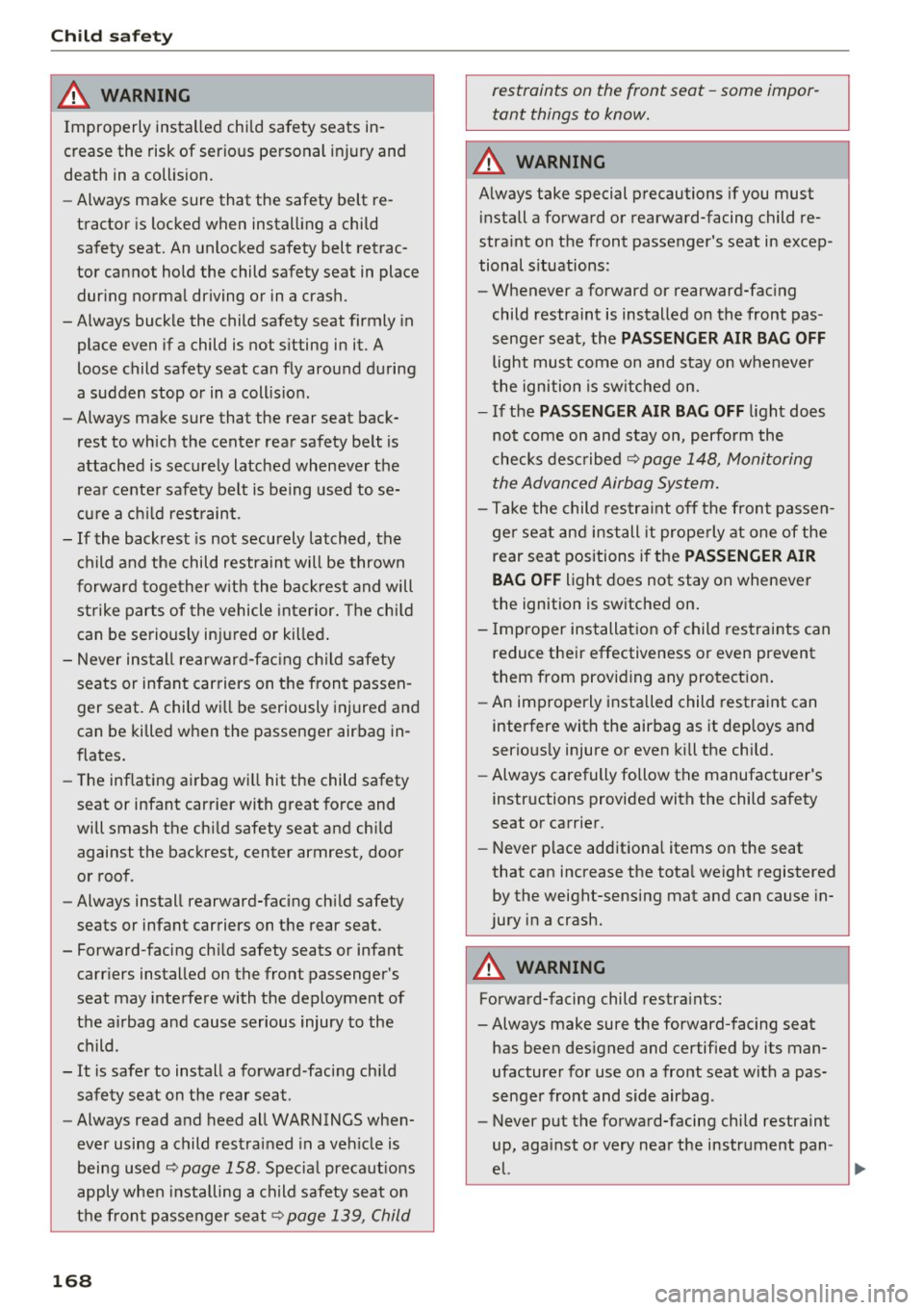
Child safet y
A WARNING
-
Improperly installed child safety seats in
crease the risk of ser ious personal injury and
death in a collision .
- Always make sure that the safety belt re
tractor is locked when installing a child
safety seat. An unlocked safety belt retrac
tor cannot hold the child safety seat in place dur ing normal driving or in a crash.
- Always buckle the child safety seat firmly in
place even if a child is not s itting in it. A
loose child safety seat can fly around during
a sudden stop or in a coll is ion .
- Always make sure that the rear seat back
rest to which the center rear safety belt is
attached is securely latched whenever the
rear cente r safety belt is being used to se
cu re a ch ild restraint.
- If the backrest is not securely latched, the
child and the child restraint will be thrown
forward together w ith the backrest and will
strike parts of the vehicle interior. The chi ld
can be se riously injured or killed .
- Never ins tall rearward-fac ing child safety
seats or infant carriers on the front passen
ger seat. A child will be seriously injured and
can be killed when the passenger airbag in
flates.
- The inflating airbag will hit the child safety
seat or infant carrier with great force and
will smash the chi ld safety seat and child
against the backrest, center armrest, door
or roof .
- Always install rearward-facing ch ild safety
seats or infant carriers on the rear seat .
- Forward-facing ch ild safety seats or infant
carr iers installed on the front passenger's
seat may interfere with the deployment of
the a irbag and cause serious injury to the
child .
- It is safer to install a forward -facing ch ild
safety seat on the rear seat .
- Always read and heed all WARNINGS when
ever using a child restrained in a veh icle is
being used~
page 158 . Special precaut ions
apply when installing a child safety seat on
the fron t passenger seat~
page 139, Child
16 8
restraints on the front seat -some impor
tant things to know.
A WARNING
A lways take special precautions if you must
install a forward or rearward-facing child re
stra int on the front passenger's seat in excep
tional s ituations:
- Whenever a forward or rearward-fac ing
child restraint is installed on the front pas
senger seat, the
PASSENGER AIR BAG OFF
light must come on and stay on whenever
the ignition is switched on.
- If the
PASSENGER AIR BAG OFF light does
not come on and stay on, perform the
checks desc ribed
~ page 148, Monitoring
the Advanced Airbag System.
- Take the child restra int off the front passen
ger seat and install it prope rly at one of the
rear seat positions if the
PA SSENGER AIR
BAG OFF
light does not stay on whenever
the ignition is switched on .
- Improper installation of child restraints can
reduce their effectiveness or even prevent
them from providing any protect ion .
- An improperly installed child restraint can
interfere with the airbag as it deploys and
serious ly injure or even kill the child.
- Always carefully follow the manufacturer's
instructions provided with the child safety
seat or carrier.
- Never p lace additiona l items on the seat
that can increase the tota l weight registered
by the weight-sensing mat and can cause in
jury in a crash.
A WARNING
Forward-facing child restra ints:
- Always make sure the forward-facing seat
has been des igned and certified by its man
ufacturer for use on a front seat with a pas
senger front and side airbag .
- Never put the forward-facing child restraint
up, against or very near the instrument pan-
-
el. ~
Page 171 of 278
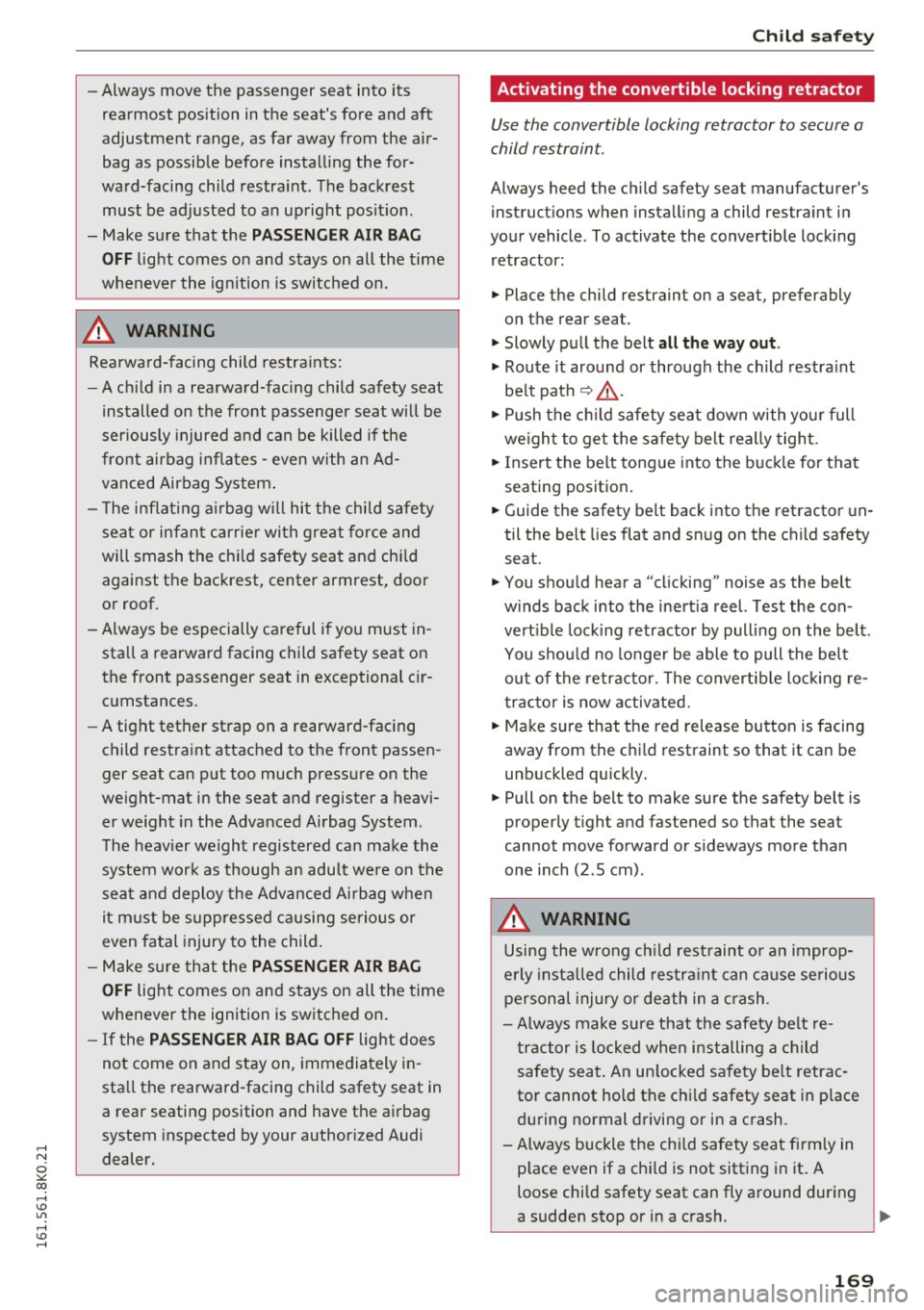
..... N
0 ::..:: co .....
rearmost position in the seat's fore and aft
adjustment range, as far away from the air
bag as possible before installing the for
ward-facing child restra int. The backrest
must be adjusted to an upright posit ion.
- Make sure that the
PA SSEN GER AI R BAG
OFF
light comes on and stays on all the time
whenever the ignition is switched on.
A WARNING
Rearwa rd-facing child restra ints:
- A ch ild in a rearward-facing child safety seat
installed on the front passenger seat wi ll be
seriously injured and can be killed if the
front airbag inflates - even with an Ad
vanced Airbag System .
- The inflating a irbag w ill hit the child safety
seat or infant carrier with great force and
will smash the chi ld safety seat and chi ld
against the backrest, center armrest, door
or roof.
- Always be especially careful if you must in
stall a rearward facing child safety seat on
the front passenger seat in exceptional c ir
cumstances.
- A tight tether strap on a rearward-facing
child restraint attached to the front passen
ger seat can put too much pressure on the
we ight-mat in the seat and register a heavi
er we ight in the Advanced Airbag System.
The heavier we ight registered can make the
system work as though an adult were on the
seat and deploy the Advanced Airbag when
it m ust be suppressed c ausing serious or
even fatal injury to the child.
- Make sure tha t the
PASSENGER AIR BAG
OFF
light comes on and stays on all the time
whenever the ignition is switched on .
-If the PASSENGER AIR BAG OFF light does
not come on and stay on, immediately in
stall the rearward-facing child safety seat in
a rear seating position and have the airbag
system inspected by your authorized Audi
dealer.
Ch ild safety
Activating the convertible locking retractor
Use the convertible locking retractor to secure a
child restraint .
Always heed the ch ild safety seat manufactu rer 's
ins truct ions when installing a child restraint in
your vehicle . To activate the convertible locking
retractor:
.. Place the child restraint on a seat, prefer ably
on the rear seat .
.. Slowly pull the belt
all the w ay out .
.. Route it around or through the child restra int
be lt path
¢ & .
.. Push the ch ild safety sea t down with you r full
weigh t to ge t the safety belt really tight.
.. Insert the belt tong ue into the b uck le for that
seating position .
.. Guide the safety belt back into the retractor un
til the belt lies flat and snug on the child safety
seat .
.. You should hear a ''cl icking" noise as the belt
w inds back into the inertia reel. Test the con
vert ib le lock ing retractor by pull ing on the belt .
You shou ld no longer be able to pull the belt
out of the re tractor. The convertib le loc kin g re
t ractor is now activated.
.. Make sure that the red release button is facing
away from the c hild restraint so that it can be
unbuckled quickly .
.. Pull on the belt to make sure the safety belt is
properly tight and fastened so that the seat
cannot move forward or sideways more than
one inch (2 .5 cm) .
A WARNING
Using the wrong ch ild rest raint o r an improp
e rly inst alled child restra int can cause se rio us
personal injury or death in a crash.
- Always make sure that the safety be lt re
tr actor is locked when installing a child
safety seat . An un locked safety be lt retrac
tor cannot hold the ch ild safety seat in p lace
during normal driving or in a crash.
- Always buckle the child safety seat fi rm ly in
p lace even if a child is not sitting in it. A
loose child safety seat can fly a round during
a sudden stop or in a crash. .,.
169
Page 176 of 278
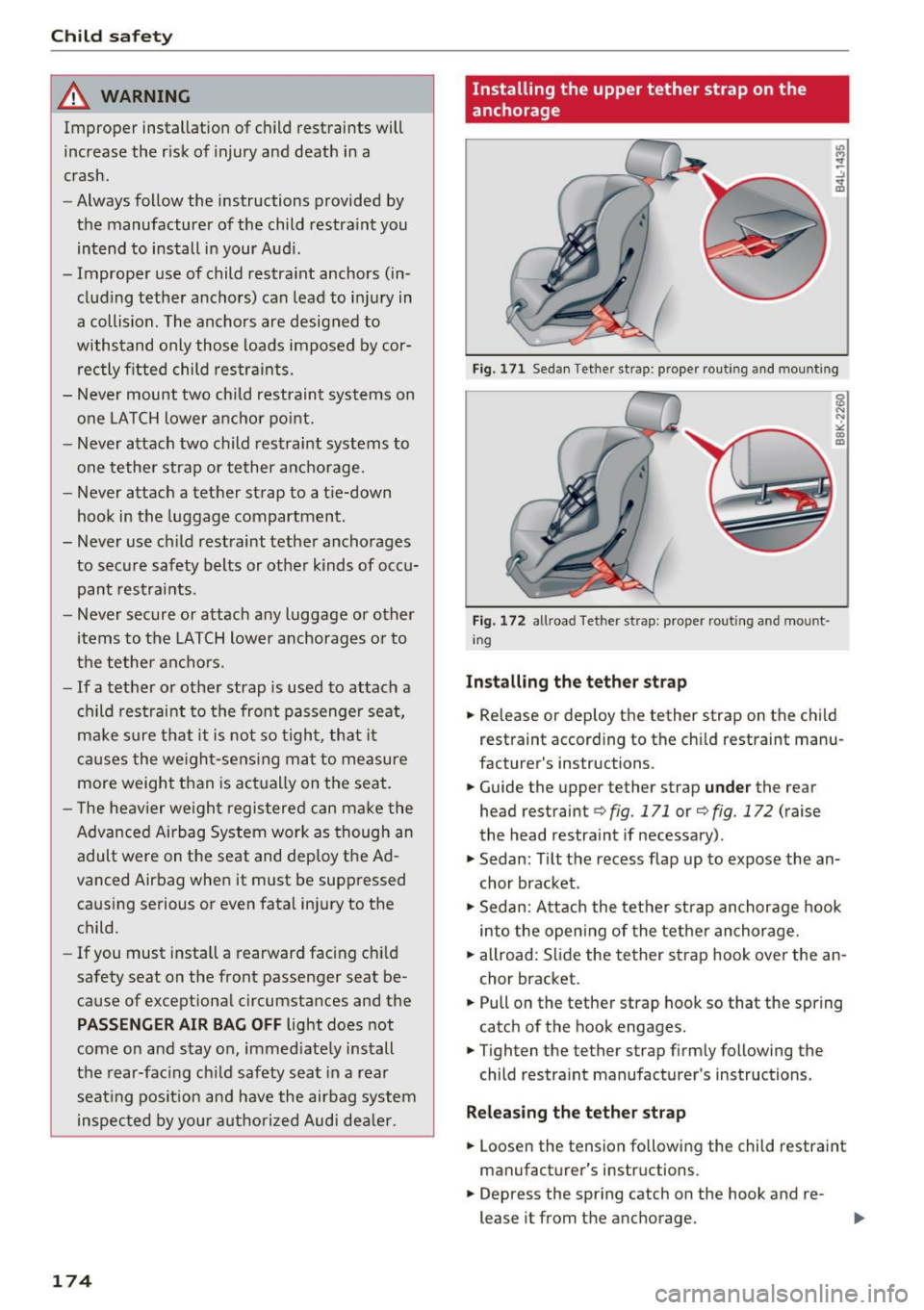
Child safety
_& WARNING
Improper installation of child restraints will
increase the risk of injury and death in a
crash.
-Always follow the instructions provided by
the manufacturer of the child restraint you intend to install in your Audi.
- Improper use of child restra int anchors (in
clud ing tether anchors) can lead to injury in
a collision. The anchors are designed to
withstand only those loads imposed by cor rectly fitted child restraints.
- Never mount two chi ld restraint systems on
one LATCH lower anchor po int.
- Never attach two child restraint systems to
one tether strap or tether anchorage.
- Never attach a tether strap to a tie-down
hook in the luggage compartment.
- Never use ch ild restraint tether anchorages
to secure safety belts or other kinds of occu
pant restra ints.
- Never secure or attach any luggage or other
items to the LATCH lower anchorages or to
the tether ancho rs.
- If a tether or other strap is used to attach a
child res traint to the front passenger seat,
make sure that it is not so tight, that it
ca uses the we ight-sens ing mat to measure
more weight than is ac tually on the seat.
- T he heav ier we igh t registered can make the
Advanced Airbag System work as though an adult were on the seat and dep loy the Ad
vanced Airbag when it must be suppressed
ca using serious or even fatal injury to the
child.
- If you must install a rearward facing chi ld
safety seat on the front passenger seat be
cause of exceptional circumstances and the
PA SSEN GE R AIR BA G OFF light does not
come on and stay on, immed iate ly install
the rear-fac ing ch ild safety seat in a rear
seat ing posit ion and have the airbag system
inspec ted by your a uthorized Aud i dea ler.
174
.
Installing the upper tether strap on the
anchorage
Fig. 171 Sedan Tether strap: prope r routing and mount ing
Fig. 172 allroad Tether strap: proper routing and mount
ing
Installing the tether st rap
... Release or deploy the tether strap on the chi ld
restraint according to the child restraint manu
facturer's instructions.
.., Guide the upper tether strap
under the rear
head restraint<=>
fig. 171 or<=> fig. 172 (raise
the head restraint if necessary).
.., Sedan: Tilt the recess flap up to expose the an
chor bracket.
.., Sedan: Attach the tethe r st rap anchorage hook
into the open ing of the tethe r anchorage.
... allroad: Slide the tether strap hook over the an
chor bracket.
... Pull on the tether strap hook so that the spring
catch of the hook engages.
.., Tighten the tether strap firm ly following the
child restra int manufacturer's instructions.
Relea sing the tether strap
... Loosen the tension following the child restraint
manufact urer's instructions .
... Depress the spr ing catch on the hook and re
lease it from the anchorage.
Page 177 of 278
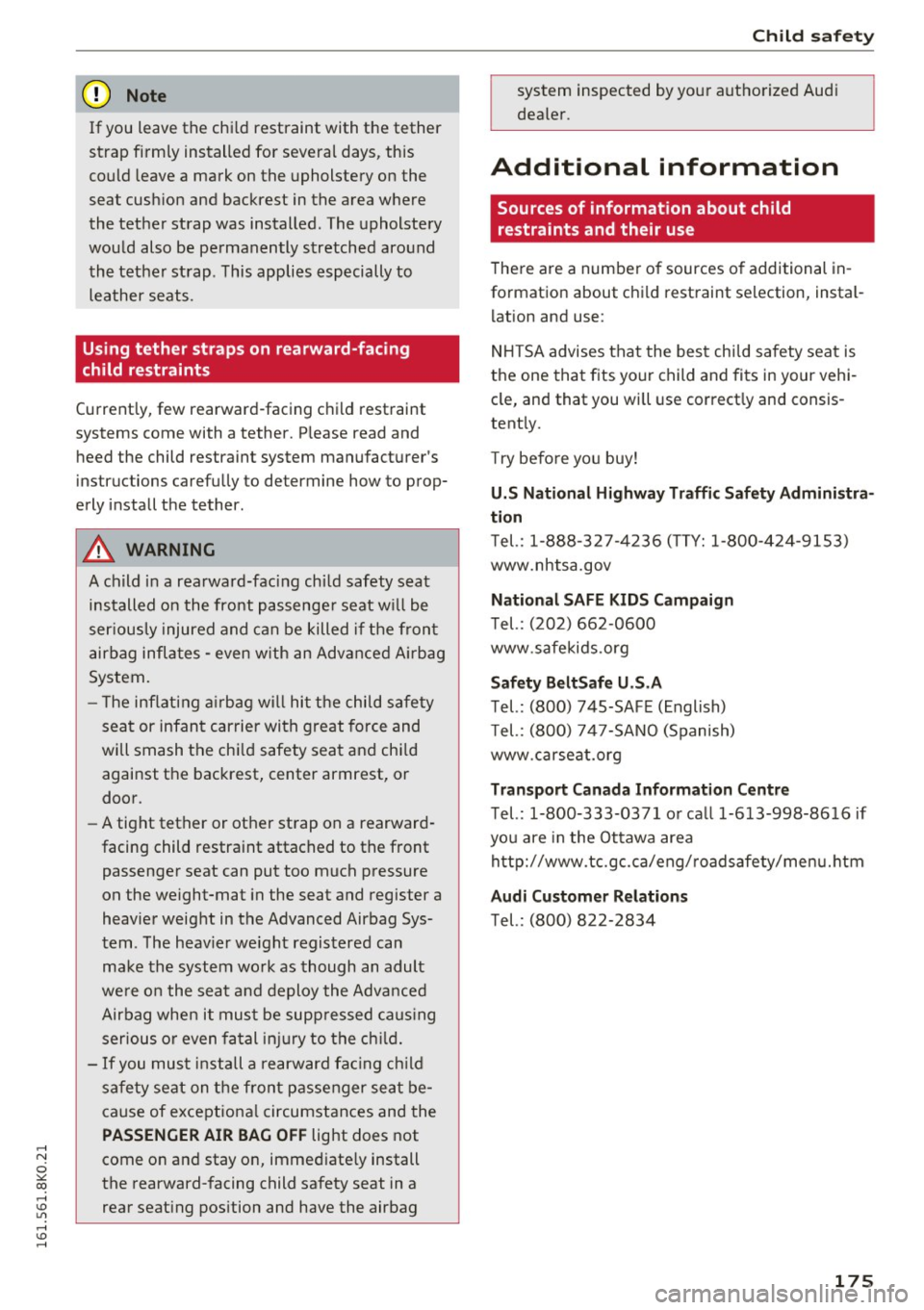
..... N
0 ::..:: co .....
If you leave the child restraint with the tether
strap firmly installed for several days, this
could leave a mark on the upholstery on the
seat cushion and backrest in the area where
the tether strap was installed . The upholstery
would also be permanently stretched around
the tether strap . This applies especially to
leather seats .
Using tether straps on rearward-facing
child restraints
Currently, few rearward -facing child restraint
systems come with a tether. P lease read and
heed the child rest raint system manufacturer's
instruc tions care fully to de termine how to prop
erly install the tether.
A WARNING
A child in a rearward-facing child safety seat installed on the front passenge r seat w ill be
ser ious ly injured and can be killed if the front
airbag infla tes · even w ith an Advanced A irbag
System.
- T he inflating a irbag wi ll hit the child safety
seat or infant carrier with great force and
will smash the chi ld safety seat and chi ld
against the backrest, center armrest, or
door .
- A tight tether or other strap on a rearward
facing child restra int attached to the front
passenger seat can put too much pressure
on the weight-mat in the seat and register a heavier weight in the Advanced Airbag Sys
tem . The heav ier weight registered can
make the system wo rk as though an adult
we re o n the seat a nd deploy the Advanced
Airbag when it must be supp ressed caus ing
serious o r even fatal in jury to the c hild.
- If you must install a rearward fac ing ch ild
sa fety seat on the front passenger seat be
cause of exceptiona l circumstances and the
PASSENGER AIR BAG OFF light does not
come on and stay on, immediate ly install
the rearward-facing child safety seat in a rear seat ing pos ition and have the airbag
Ch ild safety
system inspected by your authorized Audi
dealer .
Additional information
Sources of information about child
restraints and their use
There are a number of sources o f additional in
formation about child restraint se lection, instal
lation and use :
N HT SA advises tha t the best ch ild safety seat is
the one that fits your child and fits in your vehi
cle, and that you wi ll us e correct ly and consis
tent ly.
T ry before you buy!
U.S National H igh way Traffic Safety Administra
tion
T el. : 1-888 -327-4236 ( TTY: 1-800 -424-9153)
www.nhtsa .gov
Nati onal SAFE KIDS Campaign
Tel. : (202) 66 2-0600
www .safekids.org
Saf ety BeltSaf e U.S .A
T el. : (800) 745-SAFE (English)
T el. : (800) 747-SANO (Spanish)
www .carseat.org
Tran sport C anada Information Centr e
Tel. : 1-800-333-0371 o r ca ll 1-613-998-86 16 if
you are in the Ottawa area
http://www.tc.gc.ca/ eng/ roadsafety/men u. htm
Audi Cu stom er Re lations
T el. : (800) 822-2834
175
Page 181 of 278
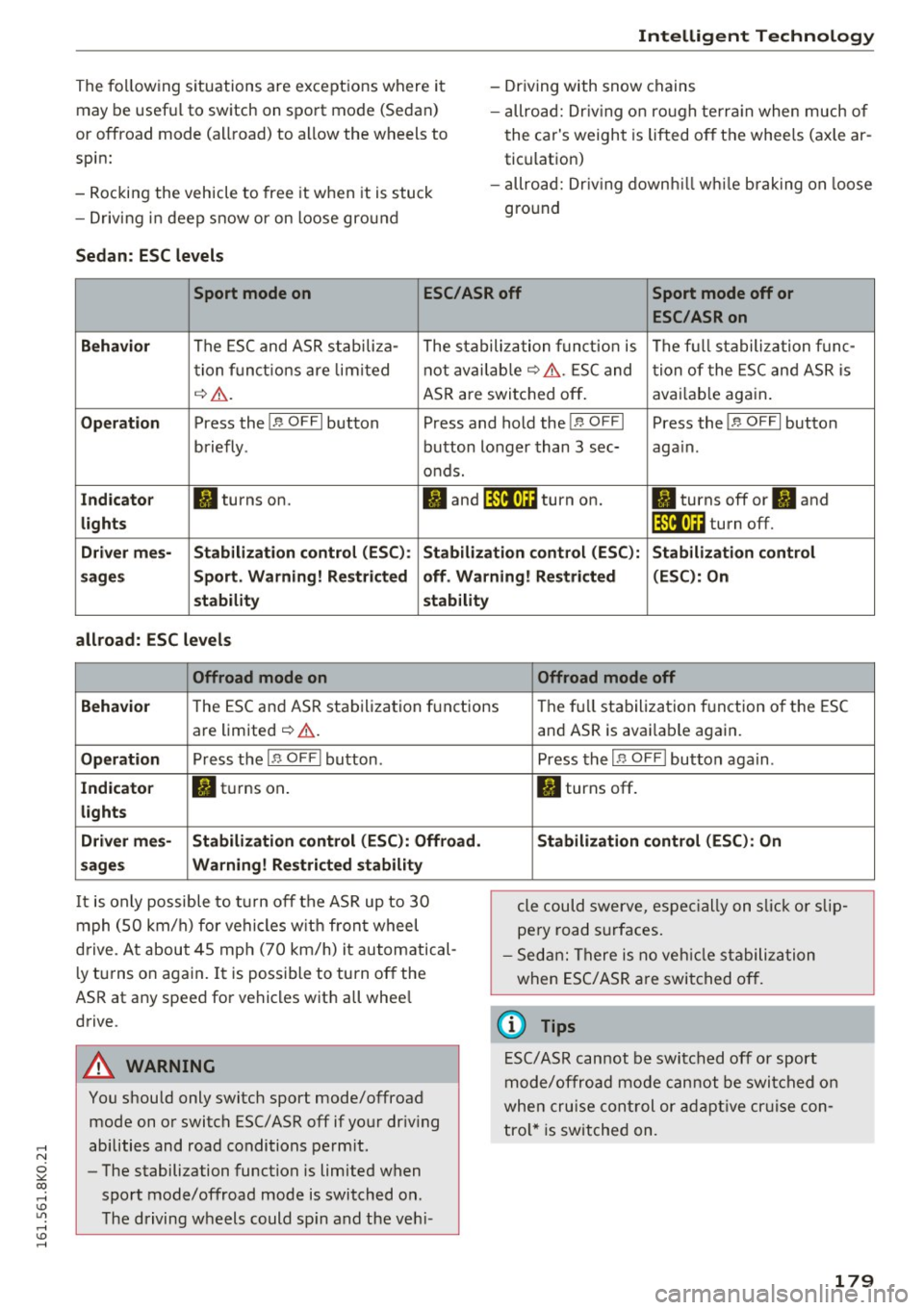
..... N
0 ::..:: co .....
may be useful to switch on sport mode (Sedan)
or offroad mode (allroad) to allow the wheels to
spin:
- Rocking the vehicle to free it when it is stuck
- Driving i n deep snow or on loose gro und
Sedan : ESC levels
Intellig ent Technology
- Driving with snow chains
- allroad: Dr iv ing o n ro ugh te rra in when much of
the car's weight is lifted off the whee ls (axle ar
tic ulation)
- allroad: Dr iv ing down hill while brak ing on loose
gro und
Sport mode on ESC/ASR off Sport mode off or
ESC/ASRon
Behavi or
The ESC and ASR stabili za- The stabilization funct io n is The f ull stabilization f unc -
t ion f unct ions are lim ited not avai lab le
~ &. . ESC and tion of the ESC and ASR is
~ &. . ASR are switched off . avai
lab le aga in.
Op eration Press the!.$ OFFI button Press and hold the!.$ OFFI Press the!.$ OFFI button
briefly . button longer than 3 sec- aga in .
o nds.
Ind icato r II turns on. fl and It'll•)~~ turn on. II turns off or II and
lights It'll•)~~ turn off.
D river me s-Stabilization contr ol (ES C): Stabilization cont rol (ESC ): S tabilization control
s age s Sport. Warning! Re stricted off. W arning! Restricted (ESC
): On
s tability stabilit y
all road: ESC levels
Offroad mode on Offroad mode off
Behavio r
The ESC and ASR stabilization f unctions The fu ll stabiliza tion f unction of the ESC
are limited
¢ & .
Operation Press the I.$ OFF I button .
In d icato r fl turns on .
light s
Driv er me s- Stabi lization control (E SC): Offro ad .
sage s Warning! Re stri cted stabili ty
It is only possible to turn off the ASR up to 30
mph (50 km/h) for vehicles w it h front wheel
drive. At about 45 mph (70 km/h) it automatical
l y turns on again. It is possible to turn off the
ASR at any speed for vehicles with all whee l
drive.
A WARNING
You should only switch sport mode/offroad mode on or switch ESC/ ASR off if your dr iv ing
abilities and road conditions perm it .
- The stabilization function is limited when
sport mode/offroad mode is switched on .
The driving wheels could sp in and the veh i-
-
and ASR is avai lable again.
Press the I.$ OF FI button aga in .
II turns off.
Stabilizat ion control (ESC ): On
cle could swerve, espe cially on s lick o r slip
pery road surfaces.
- Sed an: There is no veh icle stabili zation
when ESC/ASR are switched off .
(D Tips
ESC/ASR cannot be switched off or sport
mode/offroad mode cannot be swi tched on
when cru ise cont rol or adapt ive cr uise con
tro l* is switched on.
179
Page 182 of 278
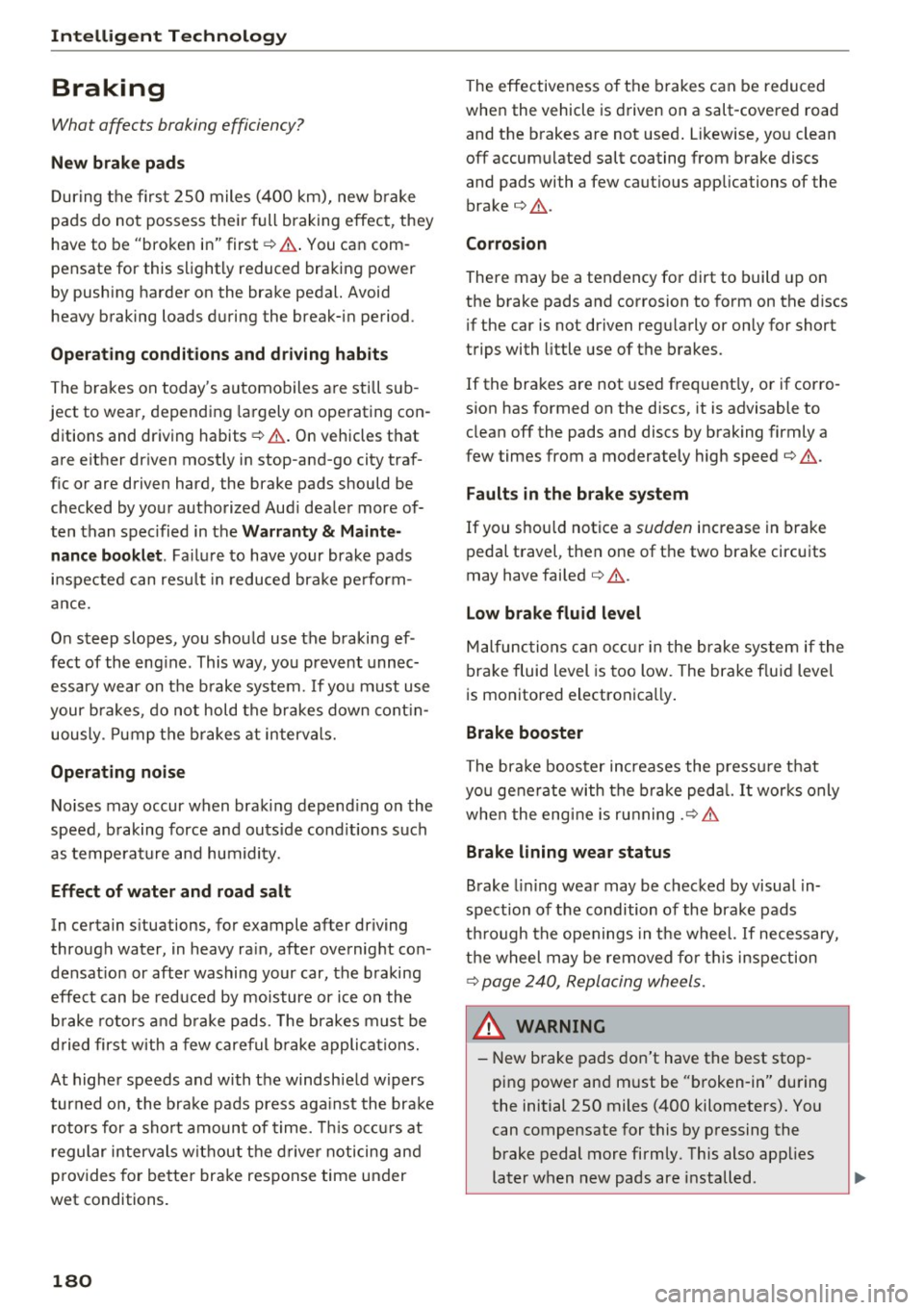
Intelligent Technology
Braking
What affects braking efficiency?
New brake pads
During the firs t 25 0 miles (400 km), new b rake
pads do not possess their full braking effect , they
have to be "broken i n" first ¢& . You can com
pensate for this slight ly reduced braking power
by push ing harder on the brake pedal. Avoid
heavy braking loads during the break-in period .
Operating conditions and driving habits
The brakes on today's automobiles a re still sub
ject to wear, depend ing largely on ope rating con
ditions and driving habits¢& . On vehicles that
are either dr iven most ly in stop-and-go city traf
f ic or are driven hard, the brake pads should be
checked by you r authorized Aud i dea ler more of
ten than spec ified in the
Warranty & Mainte
nance booklet .
Failu re to have your brake pads
i n spected c an resu lt in reduced bra ke pe rform
ance.
O n steep slopes, you sho uld use the braking ef
fect of the eng ine . This way, you prevent unnec
es sary wear on t he b rake system. If yo u m ust use
your b rake s, d o not hold the brakes down cont in
uously. Pum p th e b rakes at intervals.
Operating noise
Noises may occur when brak ing depend ing on the
speed, b raking force and outs ide cond it ions such
as tempe ra tu re and humidi ty.
Effect of water and road salt
In certain s ituations, for example after driving
through water, in heavy ra in, afte r ove rnig ht con
densat ion or after washing your car, the b raking
effect can be reduced by mo isture or ice on the
b rake rotors and b rake pads . T he brakes must be
d ried first w ith a few careful b rake a pplica tions.
At highe r speeds and with t he windsh ield wipers
tur ned on, the br ake pads press aga inst the brake
rotors for a sho rt amoun t of time. This occur s at
regular intervals w it h out t he dr iver noticing and
p rov ides for better bra ke response time under
wet conditions.
180
The effectiveness of the brakes can be reduced
when the vehicle is driven on a salt-covered road
and t he b rakes are not used . Likewise, yo u clean
off accum ulated salt coating from brake discs
and pads with a few caut ious app lications of the
brake ¢& .
Corrosi on
There may be a tendency fo r dirt to build up on
the b rake pads and corrosion to form on the discs
i f the car is not driven regu larly or only for short
trips with little use of the brakes .
If the bra kes are not used frequent ly, or if corro
s ion has formed on the discs, it is advisable to
clean off the pads and discs by braking firmly a
few times from a moderately high speed ¢ &.
Faults in th e brake system
If you shou ld notice a sudden increase in brake
pedal travel , then one of t he two brake circu its
may have failed¢& .
Low brake fluid level
Malfu nctions can occu r in the brake system if the
br ake fluid level is too low . The brake fluid leve l
is mo nitored electronica lly .
Brake booster
The bra ke booster i ncreases the press ure t hat
yo u ge nera te with the brake ped al.
It works only
whe n the eng ine is ru nning .¢ &
Brake lining wear status
Brake lining wea r may be c hecked by visua l in
spection o f the condition of the brake pads
t hr ough t he openings in t he wheel. If necessary,
t h e wheel m ay be removed fo r thi s inspe ction
¢ page 240, Replacing wheel s.
_& WARNING
- New brake pads don't have the be st sto p
ping power and m ust be " broken-in" du ring
the initial 250 miles (400 kilometers). You
can compensate for this by p ressing the
brake pedal more firmly. This also app lies
later w hen new pads are installed.
Page 183 of 278
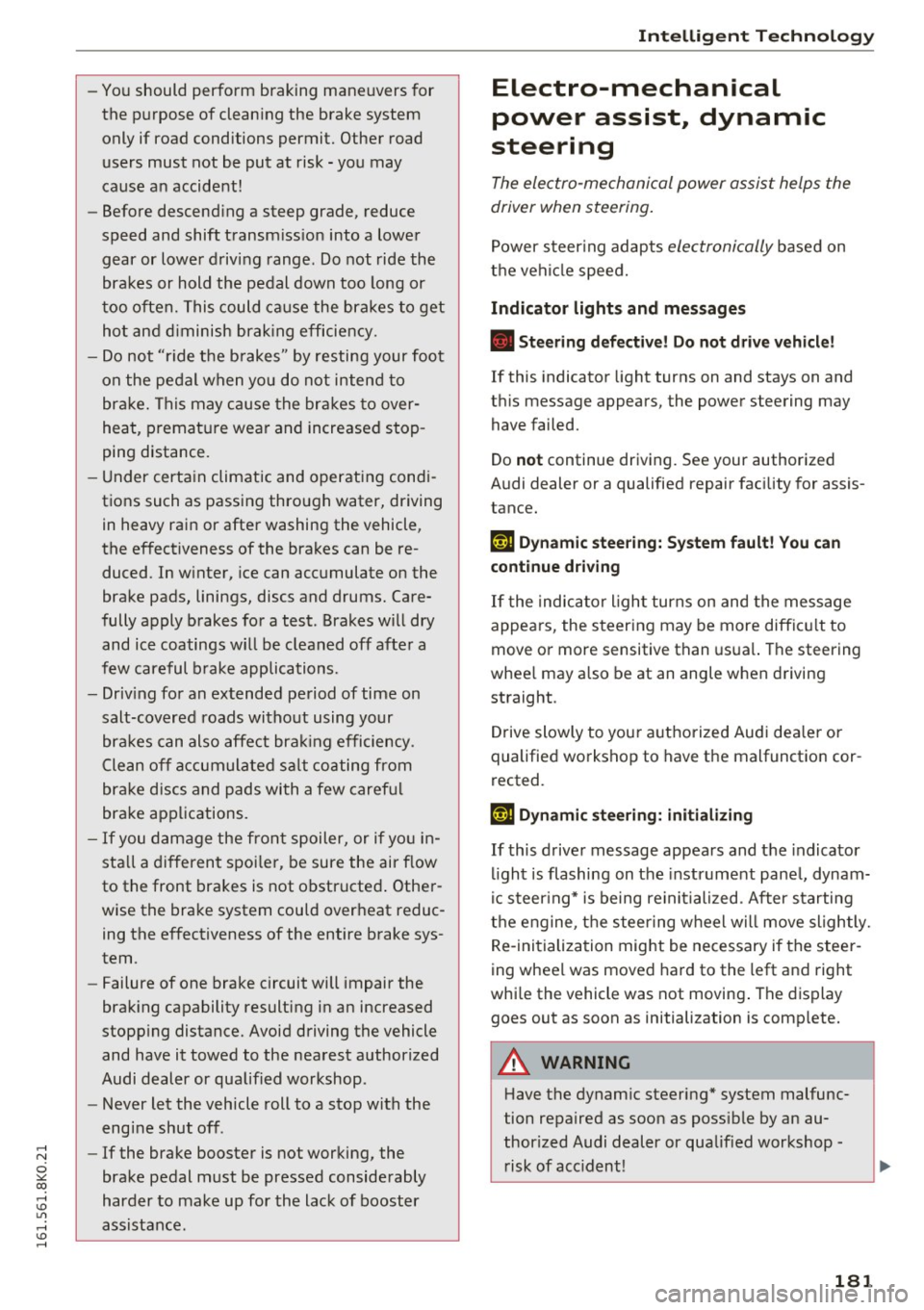
..... N
0 ::..:: co .....
the p urpose of clean ing the brake system
only if road conditions permit. Other road
users must not be put at risk - you may
cause an accident!
- Before descend ing a steep grade, reduce
speed and shift transm iss io n into a lower
gear or lowe r d riv ing range. Do not ride the
bra kes or hold the pedal down too long or
t oo often. This could ca use the bra kes to get
hot an d diminish brak ing efficiency.
- Do not "r ide t he b rakes" by resting your foot
on the pe dal when yo u do not inten d to
br ak e. This may cause the br akes to over
heat, p remat ure wea r and increased stop
ping distance.
- Under certa in climatic and operating condi
tions such as passing thro ugh water, driving
in heavy ra in or after washing the vehicle,
the effectiveness of the brakes can be re
duced. In w inte r, ice can acc umulate on the
brake pads, linings, discs and drums. Care
fully apply brakes for a test. Brakes will dry and ice coatings w ill be cleaned off after a
few careful b rake applica tions.
- Driv ing for an ex tended period of time on
salt-covered roads witho ut using your
bra kes can also affe ct bra king efficie ncy .
C le an off a ccumula ted s alt co ating from
bra ke discs and pads with a few caref ul
bra ke app lications.
- If you dam age the fro nt sp oiler, or if yo u in
st all a diff erent spoi le r, be sure the ai r flow
to the front brakes is not obstr ucte d. Othe r
wise the bra ke system could overheat reduc
ing the e ffectiveness of the entire b rake sys
tem.
- Failure of one brake circuit will impair the
brak ing capability resulting in an increased
stopp ing distance. Avoid driving the vehicle
and have it towed to the nearest authorized
Audi dealer or qualif ied workshop.
- Never let the veh icle roll to a stop w ith the
engi ne shut off .
-If the brake booster is not working, the
bra ke pedal m ust be pressed conside rably
harder to make up for the lac k of booster
assista nee .
Intellig ent Technology
Electro-mechanical
power assist, dynamic
steering
The ele ctro-mechanical power a ssist helps the
driver when steering .
P ower s teer ing adapts electronically based on
t h e veh icle spee d.
Indicator lights and messages
• Steering defective! Do not drive vehicle!
If this indicator light turns on and stays on and
t hi s message appears, the power steering may
have failed.
Do
not continue driving. See your author ized
Audi dealer or a qualified repair facility for assis
tance.
' :r, y Dynamic steering: System fault! You can
continue d riving
If the indic ator l igh t turns on and the message
appe ars, the steering may be more diffic ult to
move o r more sensitive than usu a l. T he steering
whee l may a lso be at an angle w hen d riving
straight .
Drive slowly to you r autho rized Audi dea le r or
qualified wo rks hop to have the malfunction cor
rected .
,T u Dynamic steering: initializing
If this drive r message appea rs and t he indicator
li ght is flashing on t he instrument pane l, dynam
ic s teer ing* is being re ini tialized. After s tarting
t h e engine, t he steer ing w heel w ill move sligh tly.
Re- ini tializa tion might be necessary if the s teer
ing wheel was moved hard to the left a nd right
whi le the vehicle was not moving . The display
goes out as soon as initialization is comp lete.
A WARNING ~
Have the dynam ic steeri ng* system malfunc -
tion repaired as soon as poss ible by an au
thor ized Audi dealer or qualified workshop -
r isk of acc ident!
181